Are you a wildlife enthusiast planning a trip to the Palmetto State? This article will bring you up to date on some of the rarest animals in the state. Maybe you’ll be lucky enough to spot one and contribute to saving their population! Below, we check out eight endangered animals in South Carolina!
South Carolina is diverse in geography, featuring three natural areas: the Atlantic coastal plain, the Blue Ridge Mountains, and the Piedmont region. The state is characterized by a humid subtropical climate with hot and humid summers and mild winters with minimal snowfall. However, the region is at risk of tornadoes and tropical cyclones, which naturally affect the state’s wildlife and human population.
The state’s territory is home to many plant and animal species and has two major ecosystems – bottomlands and toplands. However, habitat loss and destruction, pollution, and climate change caused many of these species to register a major reduction in their population. Some are even believed to have gone extinct in the state, although there’s still no official confirmation.
As such, we’ll discuss some species living in South Carolina that are either Endangered or Critically Endangered.
1. Kemp’s Ridley Sea Turtle
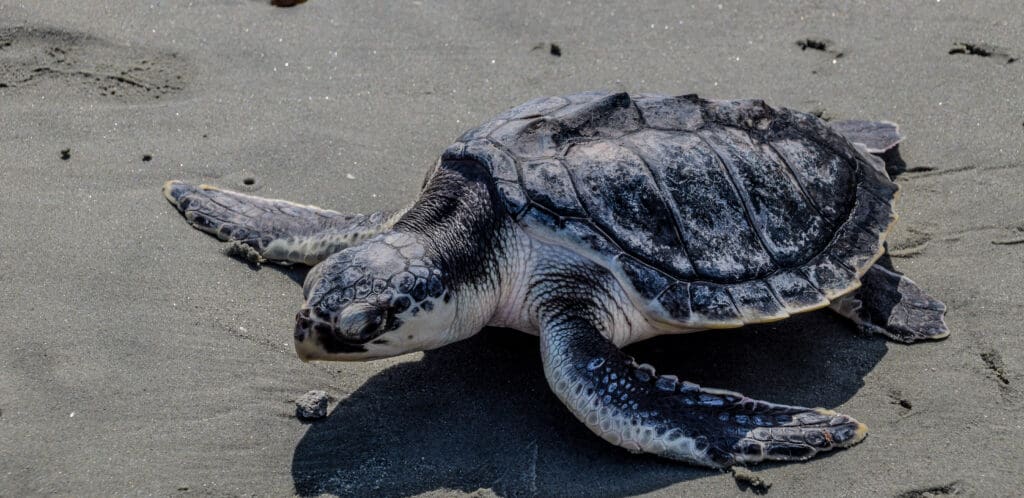
These tiny sea turtles are the rarest and most endangered sea turtle species.
©Prentiss Findlay/Shutterstock.com
Kemp’s ridley sea turtles are sometimes called Atlantic ridley sea turtles. They are the rarest and most endangered sea turtle species. With a carapace length of around 23 – 28 inches and a weight of only 79 – 99 pounds, these turtles are very small. They have dorsoventrally depressed bodies and flipper-like front limbs. The carapace is usually olive-gray and features five pairs of costal scutes.
The species caught the attention of the IUCN Red List in 1982 when it was assessed as Endangered, and it kept its status until 1996, when it became Critically Endangered. Unfortunately, everything has stayed the same since then, and these turtles live only in one single population, primarily in the Gulf of Mexico. Currently, only 22,341 mature individuals are left, representing only 20% of their original numbers, as scientists estimate that their population was reduced by more than 80% over the years.
Major threats to their population include fisheries, pollution, predation, climate change, and ecosystem alteration.
2. Spinetail Devil Ray
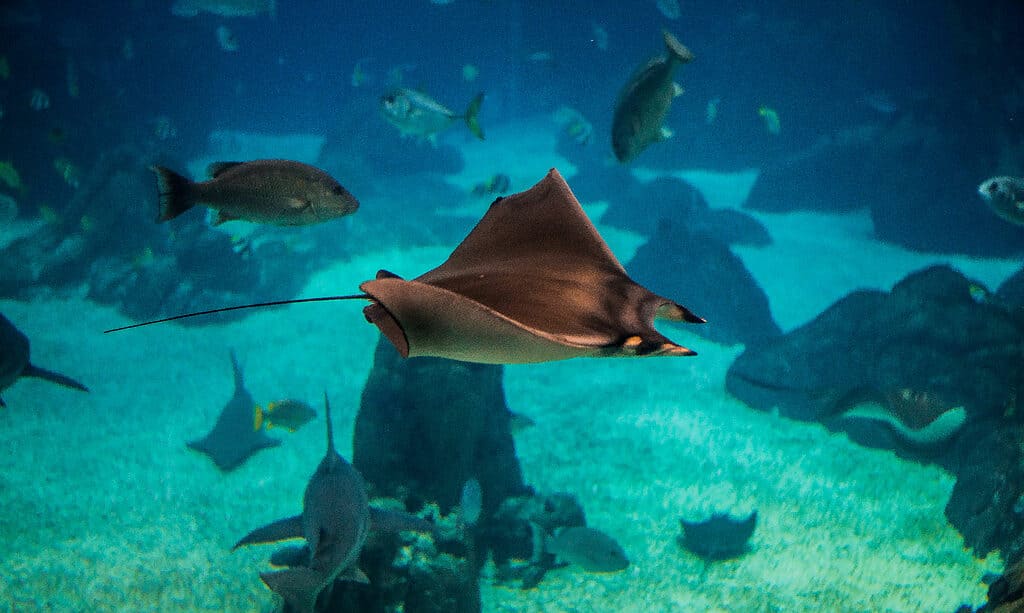
The spinetail devil ray is a large devil fish species, with a disk length of up to 17 feet.
©EloyMR/Shutterstock.com
The spinetail devil ray is most commonly called the giant devil ray or, scientifically speaking, Mobula mobular. This is a large devil fish species, with a disk length of up to 17 feet. Moreover, it can be distinguished from other devil fish by its distinctive tail spine.
Giant devil rays are found in the Mediterranean Sea and the Atlantic and Pacific Oceans. In the United States, giant devil rays can be found in the coastal and continental shelf waters of South and North Carolina, Florida, California, Georgia, Maine, and Texas. However, even though these fish have a pretty large distribution, their population is steadily declining.
Interestingly, spinetail devil rays are abundant in some regions, while only a few are left in others, depending on how many threats they face. However, certainly, they are greatly affected by targeted artisanal fisheries in countries like India, Mexico, Peru, and Taiwan. Even though there are dozens of fishing bans, fisheries are still active and direct their activity towards catching fish like spinetail devil rays.
3. Spotted Turtle
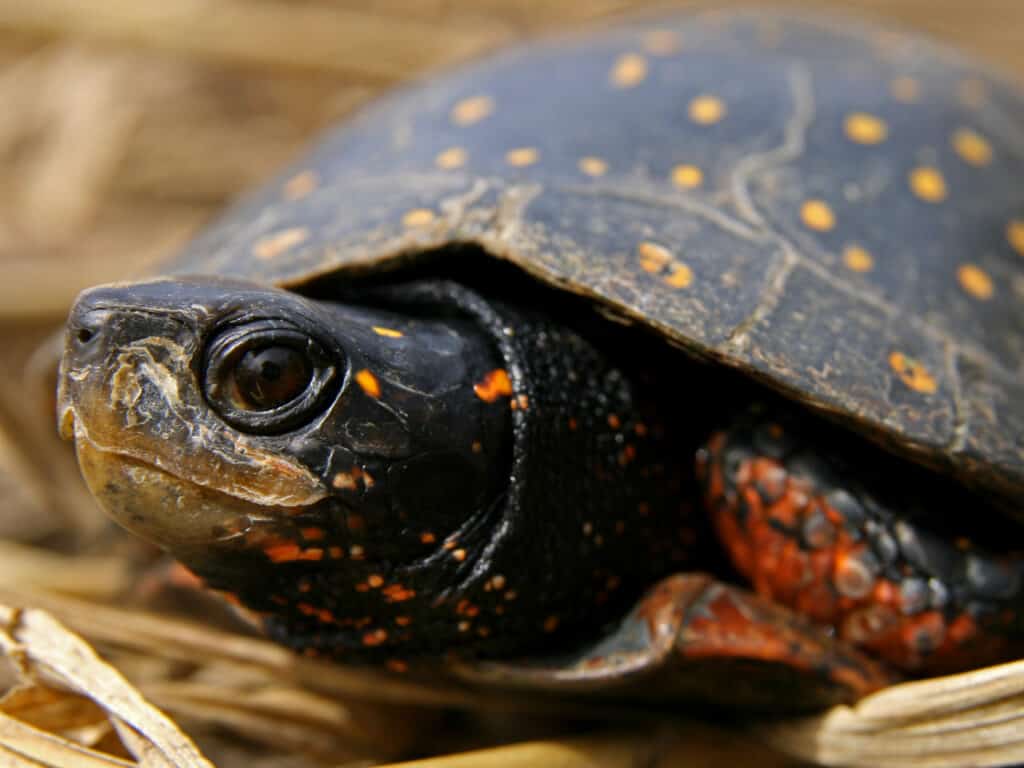
Spotted turtles are listed as Endangered on the IUCN Red List, and their population continues to decrease.
©Ryan M. Bolton/Shutterstock.com
These semi-aquatic turtles can be easily distinguished from other species thanks to their unique carapace pattern, which ranges from black to blue and features many tiny yellowish spots extending from the head to the neck and limbs. Mature male spotted turtles have long, thick tails, while females have shorter, thinner tails.
Spotted turtles live in aquatic habitats like marshes, flooded forests, bogs, woodland streams, or wet meadows. They’re widespread throughout the United States and live in South Carolina, too.
Spotted turtles are listed as Endangered on the IUCN Red List, and their population continues to decrease. Researchers believe their population has suffered a 50% reduction, primarily because of habitat loss. Moreover, since they often occur in small, localized populations, some are in decline due to a lack of recruitment and the loss of adults. Climate change, the pet trade, and predators pose a further risk to their chance of “rehabilitation.”
4. Frosted Flatwoods Salamander
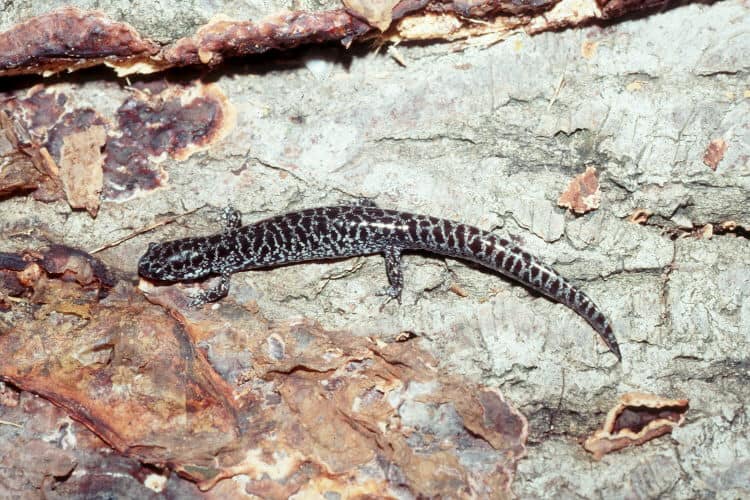
Frosted flatwoods salamanders have distinctive narrow silvery net-like markings, bands, and spots.
©USGS / public domain – License
Part of the Ambystomatidae family, frosted flatwoods salamanders are mole salamanders. These reptiles are usually a brownish purple or black color and have distinctive narrow silvery net-like markings, bands, and spots. They have short legs, long, rounded tails, and small heads.
Frosted flatwoods salamanders are found only in Georgia, Florida, and South Carolina. Before 2010, they lived in the Francis Marion National Forest in Berkeley County. However, they haven’t been spotted there since then and are believed to have disappeared from the state. Still, until further confirmation, we can hope a small population still inhabits this forest.
Frosted flatwoods salamanders typically inhabit savannas and mesic longleaf pine-wiregrass flatwoods, where they’re threatened by the interruption of the fire cycle, which can cause habitat loss. Natural fire cycle disruption can fill inhabited ponds with shrubs and other vegetation, making them unsuitable.
5. North Atlantic Right Whale
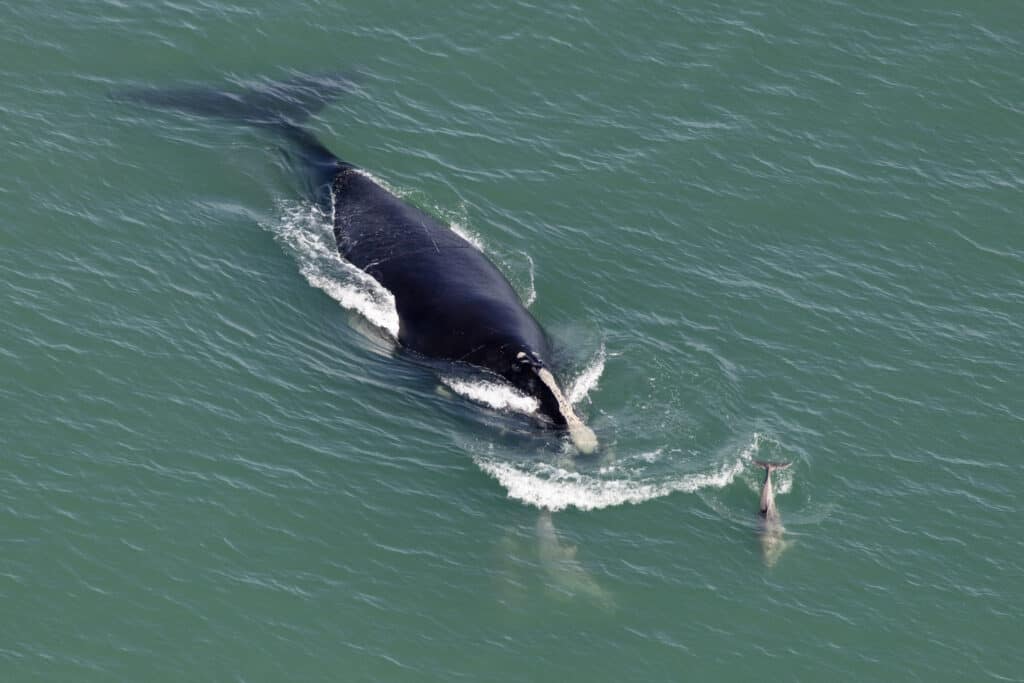
These large North Atlantic whales belong to the
Eubalaenagenus.
©iStock.com/6381380
North Atlantic right whales are among the world’s most endangered whale species. They belong to the Eubalaena genus and can be distinguished from other whales by the absence of dorsal fins on their broad backs and paddle-like pectoral flippers. These whales have a dark gray to black colors, although some have white patches on their throats and stomachs.
North Atlantic right whales are currently listed as Critically Endangered, with only 200 – 250 mature individuals left. Between 1990 and 2011, their population somewhat increased, reaching 480 individuals. Since then, however, the numbers started dropping again, falling to 409 individuals in 2018.
While they were historically at risk of hunting, North Atlantic right whales are now protected in the United States and Canada. However, many deaths are caused by entanglement in fishing gear and vessel strikes.
6. Photuris forresti
These unique fireflies are sometimes called “loopy five fireflies.” They live in marsh habitats. Photuris forresti fireflies have a unique appearance, featuring a combination of brown, light brown, and orange colors. They are found only in South Carolina, Georgia, and Tennessee and are currently listed as Endangered.
Historically, these fireflies inhabited only Pickens County, South Carolina. However, their natural habitat was eventually destroyed in 1986 during the establishment of a golf course. Since then, they moved to localities around Pickens County, reaching as far as Jefferson County, Tennessee.
As you might have guessed, residential and recreational development causes habitat destruction, which is the main threat to their population.
7. Bog Turtle
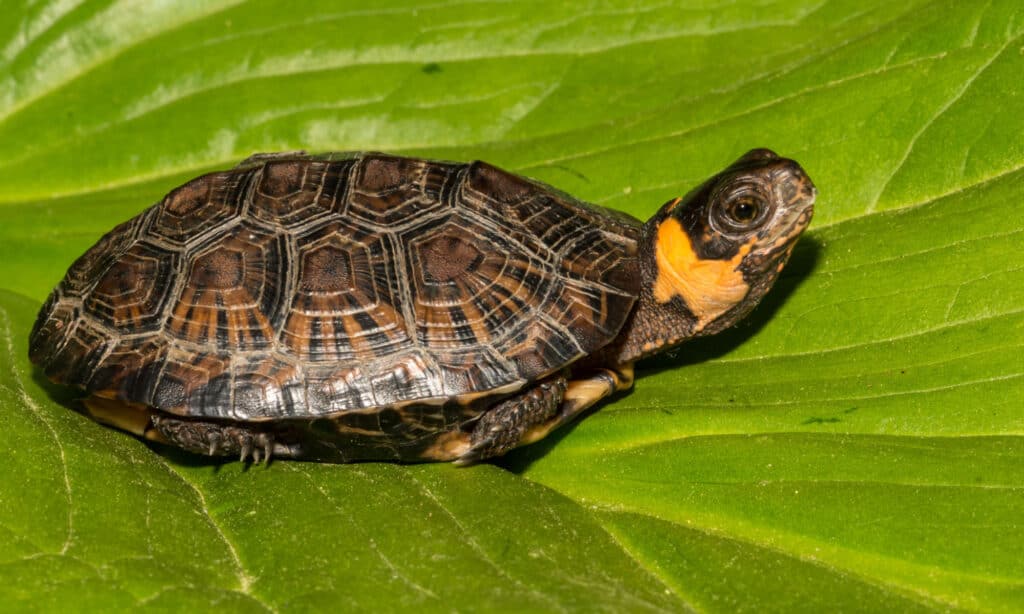
Semi-aquatic bog turtles are endemic to the eastern United States.
©Jay Ondreicka/Shutterstock.com
Bog turtles are scientifically called Glyptemys muhlenbergii. They are semi-aquatic turtles endemic to the eastern United States. Bog turtles are North America’s smallest turtle species, weighing only around 3.9 ounces and reaching an average length of 3.5 – 3.7 inches. They are often mistaken for painted and spotted turtles. However, the distinctively colored blotches on their necks can help you distinguish them from other species.
Bog turtles were assessed as Critically Endangered in 2010, as their population was believed to have suffered a reduction of 90%. It is currently found only in some U.S. states, South Carolina, Virginia, and New Jersey included.
The population numbers of bog turtles have dropped primarily because of habitat destruction caused by drainage and conversion. Moreover, even though these turtles are federally protected, they are still subject to collection for the pet trade.
8. Rusty Patched Bumble Bee
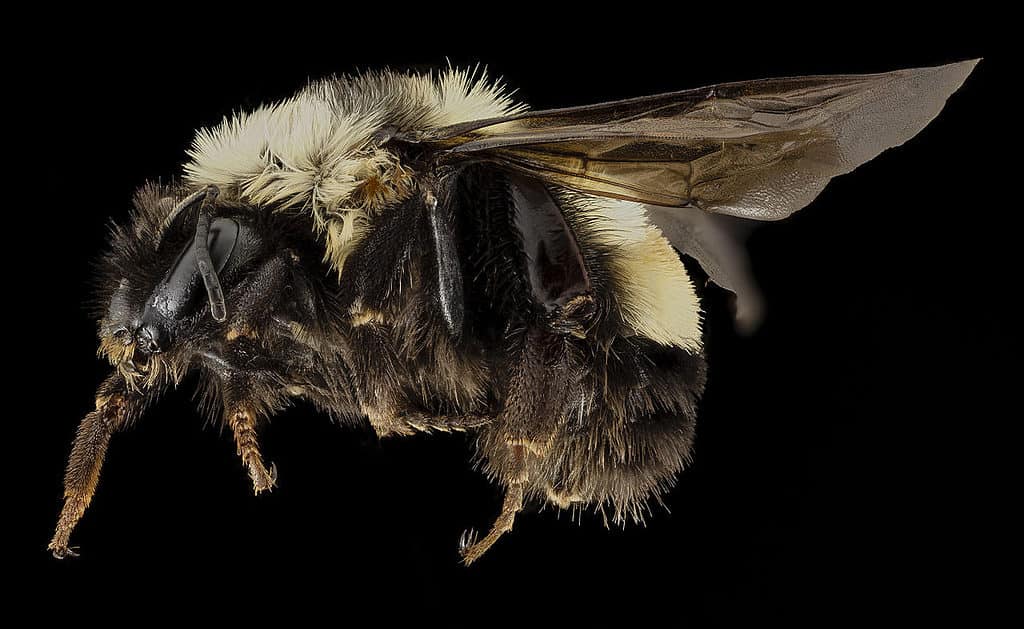
Historically, around 73,000 bumble bee individuals inhabited the United States.
©USGS Bee Inventory and Monitoring Lab from Beltsville, Maryland, USA / public domain – License
Rusty patched bumble bees are endemic to North America and are currently found throughout Canada and the United States. However, their presence is unknown in many states, South Carolina included. Despite that, since there’s no official confirmation that they went extinct in these specific regions, we can assume the bumble bees are still buzzing around these areas undetected.
Historically, around 73,000 bumble bee individuals inhabited the United States. Between 2007 and 2009, though, a study showed that only 16,000 were left. Further research showed that the average decline in the rusty patched bumble bee population stands at 69.26%.
This dramatic decline is primarily linked to pathogen spillover. Moreover, habitat loss due to development, agriculture, and climate change threaten their population.
Up Next:
- Discover the Highest Point in South Carolina
- 10 Incredible Trees Native to South Carolina
- 8 Types of Turtles in South Carolina
The photo featured at the top of this post is © iStock.com/JasonOndreicka
Thank you for reading! Have some feedback for us? Contact the AZ Animals editorial team.






